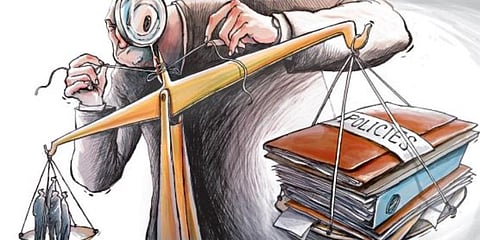

There are several interesting topics to think about, ranging from the state of the global economy to the impact of the ongoing Ukraine conflict on the Indian economy or the developments in Sri Lanka. Each of these are deserving of a dedicated column of their own—and in many instances, even deserving of a proper paper or book. But today we are going to revert to the issue of fiscal prudence, considering that several state governments are contemplating a Pay-As-You-Go type pension plan.
The Pay-As-You-Go is an interesting approach towards social security. The central idea is that the government collects pension payments today and uses it to fund social security benefits of the existing old or entitled population. The idea is an interesting one when you have a growing population that ensures there are more young people at any given point of time than the old who are entitled to get social security benefits. However, if the opposite happens, then the government will have to fund the gap between the promised benefits and the social security contribution collected from people.
It is well recognised that India is also ageing, as are most other countries. As a matter of fact, the global population is set to peak and we will eventually be in a situation where population levels will stabilise and start reducing. Therefore, it is evident that a Pay-As-You-Go scheme makes limited sense. In fact, it is in many ways a guaranteed fiscal drag on the state government’s balance sheets, which would restrict their ability to spend on necessary infrastructure. But Pay-As-You-Go is just one of the many bad economic ideas that have often become policies and been perpetuated by various state governments.
An equally bad idea is the power subsidy, originally intended for the farmers. In New Delhi, this was further extended to everyone. The consequence? Since the subsidy is up to 400 units, many houses have taken multiple electricity meters to claim the maximum subsidy amount. The subsidy therefore does not necessarily reach to all those who deserve it and it has been subject to leakages as with other similar kinds of programs. When it comes to subsidies and populist policies, we must remember the old saying that the road to hell is paved with good intentions. In the Indian context, we should perhaps just modify it to fiscal hell and the rest of it captures the state of our governments’ economic policies.
A more prudent way of giving the same electricity subsidy would be to make a per household monthly cash transfer using the Direct Benefit Transfer mechanism. This DBT-subsidy would reduce leakages and enable better targeting of such benefits given that this is a kind of rebate on the electricity costs. Ultimately, to reduce electricity costs one must subsidise solar infrastructure for houses and look at ways to improve competition between power distribution companies.
But in India, it is very difficult to stop a bad economic idea whose time has come; the power subsidy is unfortunately one of the many such ideas. People often forget that India underinvests in public goods such as policing, fire fighting services or any other urban governance. Until recently, investments in healthcare infrastructure were also inadequate and most state governments spend less on education. The case of Delhi is also a peculiar one as the state’s expense on education has gone up but the outcomes have not improved substantially, indicating a need for an evaluation of the performance of fiscal expenditures in the sector. More importantly, the lack of an adequate science stream in close to one-third schools indicates that the priority has been skewed towards “model” schools rather than a broad-based reform of the sector. Similarly, mohalla clinics are another area where substantial fiscal resources were devoted in Delhi. These clinics are similar to primary healthcare centres across the country. However, these clinics were not of any assistance during the pandemic, which raises questions about the efficacy of fiscal resources devoted to them.
The underlying point here pertains to the need for a rigorous assessment of the quality of expenditures by various state governments. That such an assessment is not done by the states nor by the commentariat is a great tragedy that leads to perpetuation of policies without any evaluation. No wonder on many development outcomes we lag, and even where we do seem to be doing well we are unable to identify the causes behind our success.
All is not as gloomy as it may appear to the reader, as several states have initiated dashboards to provide real time data for evaluation of progress. Economist Rahul Bajoria incidentally mentioned “dashboard governance” becoming well entrenched in Indian policymaking, which will make a departure from the convention going forward. The Union government has incidentally made several dashboards for its key initiatives while the finance ministry has also started preparing a detailed outcomes report to accompany its Union Budget as a supplement to the expenditure Budget. Here’s hoping that state governments too begin their assessment regarding the quality of their spending. Ultimately, India’s growth will come from its states and therefore, good fiscal spending by them to promote economic growth will help our nation’s growth.
Karan Bhasin
New York-based economist
(karanbhasin95@gmail.com)